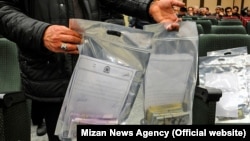The exchange rate for the US dollar against the Iranian currency, tuman, rose to a record high on March 13 as attempts by the Central Bank of Iran (CBI) during recent months to defend the local currency appear to have failed.
One dollar was traded for 4,800 tumans in Tehran on Tuesday, showing yet another hype since its steep decline began 10 months ago.
The Central Bank of Iran has been resorting to short term measures to control the market as its long-term policies to bring about stability to forex market have failed.
Based on one of these short-term polices, dollars are sold to passengers going abroad according to a ration that depends on their destination. Those travelling to countries that have a visa waiver policy for Iranians are allowed to buy 500 dollars per person. Those travelling to countries that require visa are able to buy 1000 dollars.
Reports from Tehran say there are long queues at the tills as there are many who buy 500 dollars on one side of a street and sell it at a higher price in the black market on the other side.
At the same time, the CBI has sought help from the police to clamp down on street corner traders and even some authorized money changers.
The short-term policies are meant to help preserve a measure of credibility for the CBI and the regime as a whole.
It is obvious that the essential reason behind the devaluation of the Iranian currency is inflation, which is a by-product of the government’s budget deficit, and the inefficiency of the Islamic Republic’s economic system.
Budget deficits and economic inefficiency are among the key characteristics of an economy based on advantages for regime insiders.
But why demand for foreign currency has dramatically risen during recent months?
Part of the demand for foreign currency is natural and usual at certain times such as a spike in foreign travel before the Iranian New Year.
A larger part of the demand for foreign currency, however, is the result of multiple rates of exchange and the activities of dealers and middlemen seeking high profits. The government offers cheaper dollars for some import and other transactions, while there is a free market with more expensive dollars.
A single rate of exchange would limit the activities of the dealers and profiteers. But the government has failed to unify the rate.
There are at least two more reasons for the rise in the value of foreign currencies. One is a drop in interest rates; which has channelled a lot of withdrawn savings into the market as cash.
This cash usually flows into the foreign exchange market and the housing market.
With the current problems in the banking system and the difficulties involved in the construction business, most people would prefer to convert their capital into foreign currency, mainly US dollars.
The second problem is caused by capitals that lave left the country. News agency reports say that following the anti-government demonstrations in December and January there has been an eye-catching rise in migration of capitals from Iran mainly to the UK, Canada and Turkey.
Meanwhile, the foreign currency market in Iran appears to have been affected by some domestic and international political developments.
Massive demonstrations in December 2017 and January 2018 against political and economic inequality and the violent way the protesters were treated, have questioned the country’s political stability.
Constant in-fighting among regime elements such as exchange of harsh words between the President, the Judiciary Chief and the Supreme Leader have also added to the tensions and given rise to the sense of political instability.
The same kind of exchange of rhetoric between Iranian leaders and US, and sometimes European, officials about the fate of the nuclear deal, as well as Ian’s missile program and regional ambitions also plays a key role in capital migration from Iran.
The Central Bank’s short-term policies cannot solve long-term problems. Long-term stability of the market in Iran depends on bringing about structural economic reforms. This includes the ability to put an end to domestic and international tensions.
It is unlikely that the Rouhani administration could introduce these structural changes without fundamental changes in Iran’s political system; the role and the vast authority of the Supreme Leader and the military and religious institutions he runs.





